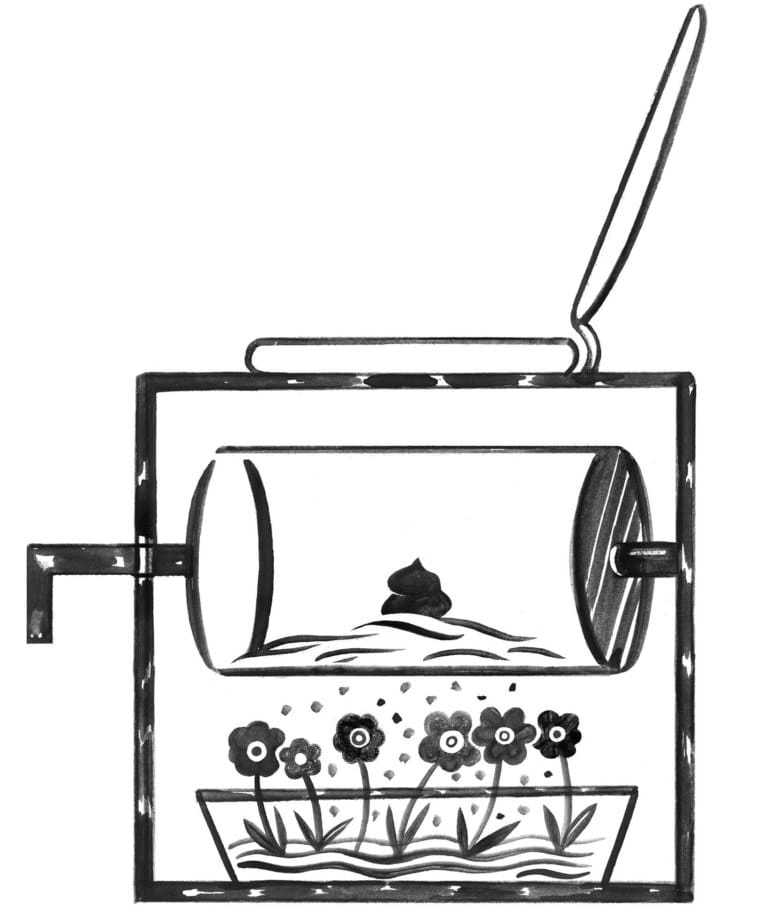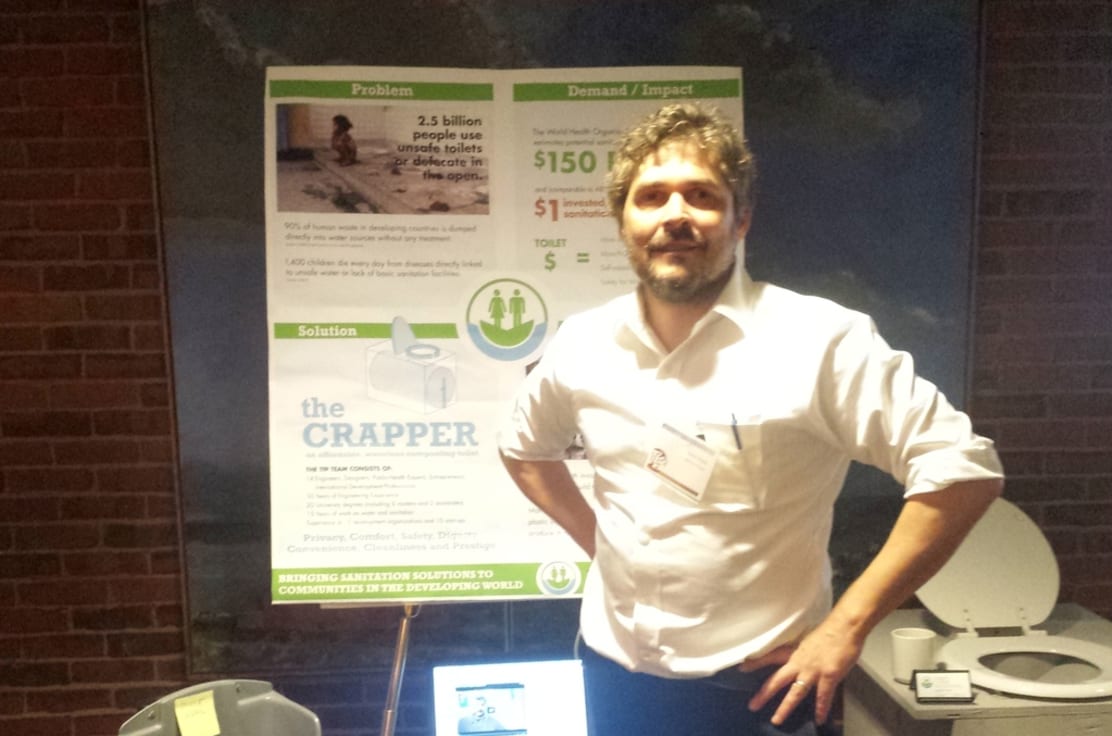Jason Kass explains he combined the rotating drum and urine diversion aspects
Wow in 2017 a woman from India created RevoLOOtion - inspired by Jason Kass!! Now she does her business as https://www.pointofshift.com/ on sustainable composting toilets.
the flap door closes when you spin counterclockwise! Nice. "If three people are using it then you empty the toilet bin once every two months" - so for one person that's once every six months! At 4 gallons of compost it's half full and needs to be emptied but only 1 gallon comes out of the flapper door. The capacity of the 2nd bin is 5 gallons. Meanwhile it's composting in the aerator rotating drum for six months also. If I use Oyster Mycelium in the rotating drum then that will compost it even faster! So cool.

We call it the compact, rotating, aerobic, pollution-prevention, excreta reducer—otherwise known as the CRAPPER.
There is no mixing or aeration; and without mixing, there is little or no composting. So what happens when the first vault fills up? Well, in theory, it’s the owner’s job to shovel out what is supposed to be ready-to-use compost to fertilize their garden. In reality, no one wants to shovel a cubic yard or more of non-composted human waste by hand. From my experience, without exception, what happens is that these pits fill up in a year or so, smell terrible, and are abandoned.
But when done right, nothing is more effective than composting, especially for flood-prone areas.
Toilets For People has invented the CRAPPER, an affordable composting toilet for people in developing countries that costs $200. Jason Kass founded Toilets For People in 2012 as a social business that in addition to providing the toilets, trains NGO partners in the developing world how to install and maintain these toilets. So far, Kass and team have been recognized by Columbia University’s Engineering Ventures Competition where they took first place, at this year’s Cleantech Open Northeast regional competition where they received the Global Impact award and were finalists in startup competitions at Wharton, MIT and Harvard.
https://www.globalwateralliance.net/the-crapper/
To use, start by filling the drum with 1 gallon of damp and loose compost material — coconut coir is popular. Then you pee and poop as you do. No need to cover it with saw dust, dry leaves, or ash afterwards, you just spin it once after every use. The urine diversion system routes the urine (which is generally sterile) either into a container for later disposal or is discharged directly into a soak pit.
There is no need to clean the drum and the bin – it is actually better if some material carries over to start the composting process with the next batch.
https://www.toiletsforpeople.com/
https://www.toiletsforpeople.com/tfp-compost-toilet-details
Chamber 1: Rotating Drum
The first chamber your solid waste will travel to is the rotating drum which will actively decompose organic waste. There is a layer of dried organic material already inside. Commonly used is coconut coir, which is the hard fibrous material of the coconut. After every use, you would rotate the drum clockwise with the rotating rod at the front of the toilet to aerate and mix. You do this just like you would flush the toilet after each use. But to actually flush/ empty the drum, you would pull the flush mechanism to unlock the drum and rotate the drum counterclockwise to open the drum door and empty into the second chamber. Every 2 weeks, with normal usage by two adults, some of the waste in the drum needs to be emptied into the finishing drawer (Chamber 2) by turning the drum counterclockwise.
Chamber 2: Finishing Drawer
The second chamber enables further aerobic decomposition passively. You allow it to sit for a further 6 weeks after release from the rotating drum. Then you open the door at the front of the step-up, and pull out the finishing drawer. The waste inside the drawer is ready to be buried in your yard. If you purchased an extra Finishing Drawer, you can also put the included lid on top of the used one to store for longer composting after replacing the drawer with an empty one. We recommend burying a foot under ground with a layer of wood ash, charcoal ash, or agricultural lime on top of the compost (this is to further dry it out & raise the pH which kills the pathogens thereby disinfecting the waste).
https://www.pbs.org/newshour/health/4-innovative-toilet-designs-to-talk-about-on-world-toilet-day
So this composting toilet design provides a six month minimum turn around!! In fact for one person it would be a year! He says 3 months for two people - per barrel. So you rotate the barrel a few times a week. You then EMPTY the barrel once every three months! But that is for 2 people. For 1 person then you empty it every six months and then empty the 2nd bin once a year!!
The idea that Thomas Crapper invented the flushing toilet (and that’s why we use the word ‘crapper’ as an informal toilet term) isn’t completely true.
Thomas Crapper did have something to do with the flushing toilet, but he was not an early toilet inventor.
Instead, Thomas Crapper ran the first toilet and sink display store in King’s Road, which he called Crapper & Co. It would become one of the first and most successful places that people could go to pick out their own toilet.
Crapper didn’t invent the toilet, but instead sold them to businessess and the public.
https://www.indiegogo.com/projects/toilets-for-people-join-the-movement#/
1.5 pounds of oyster mushroom sawdust to start it. Then a handful each time after.




No comments:
Post a Comment